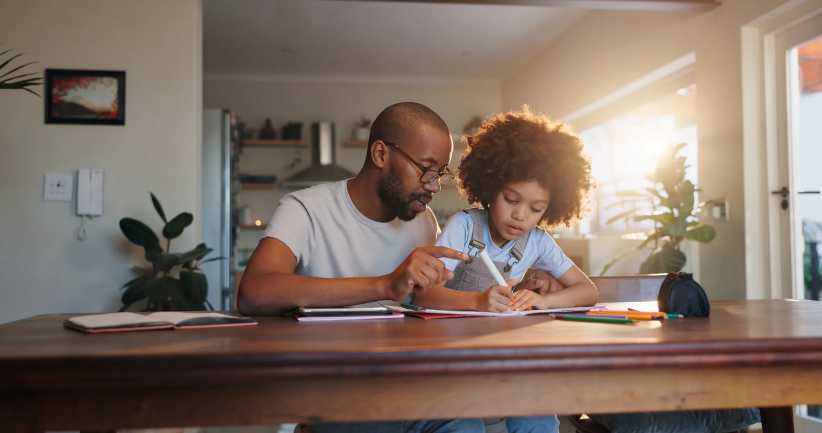
Make Homeschooling and Homework Easier: 6 Practical Tips for a Positive Learning Space at Home
Easy ideas to help homeschoolers—and all kids—stay curious, focused, and excited to learn
One of the biggest benefits of homeschooling is the flexibility to shape learning around your child’s interests, pace, and environment. However, creating a space where that learning really thrives takes a little intention. Still, a positive classroom environment at home doesn’t have to be complicated; it just needs to feel calm, inspiring, and tailored to your child’s needs.
We consulted K12.com, a leader in online education, for tips on how to best set up your kids to learn at home. These tips are especially great for homeschool families looking to make everyday life part of the curriculum. And they also work beautifully for kids who come home from school needing a quiet, supportive place to study and do their homework.
Psst … Check Out Is Unschooling Right for Your Child?
From turning daily chores into hands-on lessons to weaving curiosity into everyday conversations, here are six simple ways:
1. Turn Everyday Chores Into Learning Opportunities
One of the best parts of at-home learning is that daily tasks can double as lessons. Watering the plants? Use this as an opportunity to discuss photosynthesis, explaining how plants convert sunlight into energy to grow. Measuring soil moisture can become a quick science experiment, tracking plant growth over time to teach patience and observation.
Chores like cooking also provide endless opportunities. Ask your child to help measure ingredients and explain fractions while you cook. Folding laundry? Turn it into a lesson on sorting, patterns, or basic math by counting pairs of socks. These simple, hands-on activities bring lessons to life, showing kids how learning connects to the real world.
2. Create a Learning-Rich Home
Making your home a learning-rich space means setting up areas where curiosity thrives and inspiration is woven into daily routines. Start by creating a dedicated, comfortable workspace with essentials like notebooks, pencils, and subject-specific tools. Surround this space with materials encouraging exploration, such as bookshelves filled with fiction, nonfiction, and educational games.
Go beyond the desk, too. Hang up maps in the hallway or display a calendar featuring daily facts. Create a “question corner” where kids can write down things they wonder about and set aside time each week to explore them together.
3. Encourage Curiosity Through Everyday Conversations
Kids are always learning, even during everyday conversations. When they mention something interesting, follow up with open-ended questions like, “Why do you think that happened?” or “What would you do differently next time?” This keeps their minds active and encourages critical thinking.
Guide discussions toward discovery. If they talk about a favorite TV show, discuss the storyline, character motivations, or the science behind special effects. If you are walking the dog and notice changing weather, talk about seasons, climate, or how animals adapt. You do not need to turn every conversation into a lesson; just keep curiosity alive by letting kids explore ideas naturally.
4. Foster a Love for Reading
A love for reading is one of the greatest gifts you can give your child. Reading boosts brain function, reduces stress, and strengthens comprehension skills. Creating this habit does not have to feel like a chore.
Allow children to explore different genres, like adventure, mystery, or nonfiction. Keep books within reach around the house and set aside family reading time, whether it is before bed or through audiobooks. Visit your local library. Make reading a natural part of the day by discussing books over meals or during downtime.
5. Transform Screen Time Into Learning Time
Screen time is a big part of life, especially for students in online school. But it can be more than just logging into lessons or scrolling through apps. With a little creativity, screens can become powerful tools for learning and exploration.
Introduce educational content like interactive science videos, coding games, or virtual museum tours. Use apps that teach problem-solving, languages, or creativity to balance entertainment with learning. View or play educational games together to discuss what they are discovering.
6. Model Lifelong Learning
Children learn by observing the people around them, especially their parents. When they see you curious, engaged, and open to new experiences, they are more likely to adopt the same mindset. Share your interests and learning moments with them, whether reading a new library book, trying a recipe for the first time, or researching a topic online.
Involve them in your learning process. If you are troubleshooting a project or picking up a new hobby, talk through the steps you are taking and the challenges you are facing. Let them see that learning is a lifelong journey.
Tips originally published on online learning solution K12.com.
Psst … Check Out 40 New After-School Sites Coming to NYC Next Month: Is Your Child’s School on the List?












